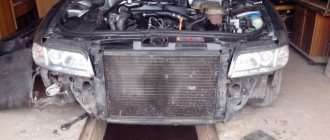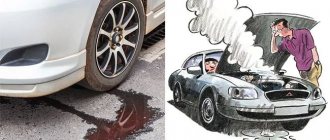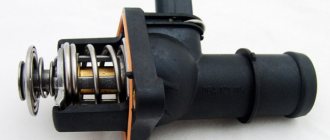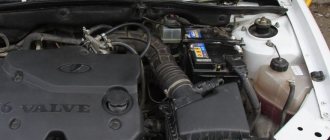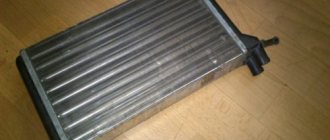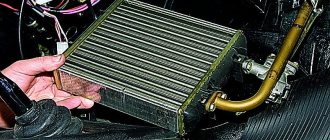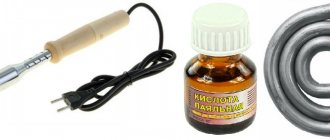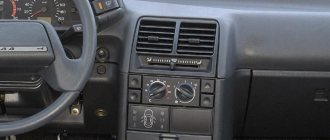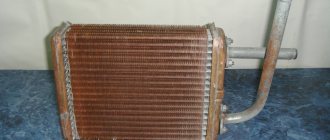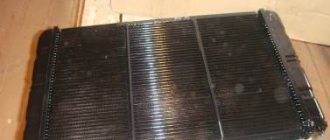There are two types of malfunction symptoms in the cooling system of a car engine: the engine slowly reaches operating temperature or quickly overheats. One of the simplest methods of rough diagnosis is to check with your hand the degree of heating of the upper and lower radiator pipes.
Below we will look at why the internal combustion engine cooling system may not work well and what to do in such situations.
Why is it necessary to warm up the engine?
Warming up the engine began in the last century, when the vehicle was moved after the engine had reached the desired temperature. Warming up occurs at idle speed. Before moving, you need to wait a few minutes so that the motor does not stop along the way. All parts warm up and function normally. Warming up is necessary to ensure normal engine operation, narrowing the gaps between parts, maintaining the required viscosity of the engine oil and reducing fuel consumption.
It is important to know
Beginners often make the mistake of believing that the lower pipe should never be cold, and they begin to sound the alarm.
Advice:
(especially useful during winter): Drive the car into the garage. Let the engine run for 10-20 minutes so that this same pipe has time to heat up, and only then draw your conclusions.
The fact is that due to the lack of heat in the cooling system (cold season), the thermostat keeps a large circulation circle closed. If the heater is on, it will prevent the thermostat from opening. Therefore, it must be turned off while the engine is warming up.
If after this the lower pipe is cold, there is a problem.
How to determine if the engine is overheated
At first glance it seems very simple - according to the indicators of the engine temperature device, or - sensor. This is true, if not for one thing - novice motorists are so captivated by the road situation around them that they look at the instrument panel only in one case - how much fuel is left. Experienced motorists, on the contrary, due to their confidence in their abilities, also do not look at the car’s dashboard. And as a result, a situation often arises that overheating is detected when the engine temperature has long exceeded permissible limits, and irreparable damage has been caused to the engine. It is irreparable overheating that is one of the most complex malfunctions, which leads to very serious consequences. But more on that later.
But there is a way that will not let you miss the moment of overheating. This is problematic in a traffic jam, and is not always clearly present, but here’s what you should be aware of:
— As soon as the engine temperature exceeds the permissible norm, when you sharply press the gas pedal, or when accelerating the car, even slightly, detonation knocks can be clearly heard
, which are popularly called “tapping fingers.” This is not true, but everyone knows this definition.
If you hear such a sound, there is a 99% chance that the engine has overheated, and action must be taken.
Detonation knock is a loud metallic knock, the frequency of which coincides with the engine speed. You've probably heard such sounds when refueling with low-quality fuel. I personally don’t know where the concept of “tapping fingers” came from. But the real reason for such knocking noises is a disruption in the fuel combustion process. What you hear is nothing more than explosions of the fuel mixture. During normal engine operation, the combustion process is controlled, but as soon as one of the operating parameters is violated, the process goes out of control and combustion turns into an explosion. Hence the concept - detonation (from the word detonate - explode) knocks. When the engine overheats, this is the first sign.
Before continuing the conversation, let's define what is normal temperature and what is overheating. There is no one-word answer, but there are general rules.
The engine temperature is within 85-95 degrees Celsius, which is working.
Engine temperature up to 100 degrees is acceptable. This means that a short-term increase in temperature to 100, sometimes up to 105 degrees is allowed. Just for a short time - up to 5 minutes.
Engine temperature above 105 degrees Celsius means overheating and action must be taken.
Reasons that can cause overheating
1.Lack of coolant. The liquid in the engine boils not because there is not enough of it, but here’s why: remember about the outer surface for cooling? If there is a lack of fluid, the contact surface between the fluid and the heated engine is insufficient, and heat transfer to the environment is poor. This is where the overheating comes from. The engine cooling system is not sealed, as many believe, and fluid evaporates during operation - do not forget to check its level regularly. And of course, monitor the condition of the radiator and pipes - leaks are unacceptable. There are cases of internal leakage - as a result of damage to the gasket between the head and the cylinder block. Water will not flow out of the exhaust pipe, but a constant decrease in the fluid level without visible leaks is a reason to be wary and contact a specialist. Water accumulated in the cylinders at the moment of starting the engine can lead to water hammer - this can literally destroy the piston group, and not only that.
2. Radiator condition. The gaps between the radiator honeycombs are quite small and can gradually become contaminated by representatives of the insect world. This is not a joke; there was a case when minor contamination of the radiator (coupled with the poor condition of the engine) led to constant overheating of the car. Keep the radiator clean and blow it with compressed air at least occasionally.
3. Incorrectly set ignition angle. If the ignition angle is violated, the fuel combustion process is disrupted. As a consequence, an increase in combustion temperature and a decrease in power. The power has dropped, but there is no need. What are we doing? That's right - press the gas pedal harder. It turns out that more fuel is spent on the design operating mode of the engine (at which normal cooling occurs). Hence the overheating. By the way, an ignition problem can arise (spontaneously, and not after your intervention in the finely tuned engine mechanism) if the timing belt or chain is stretched. This is not the only possibility, but it is common - keep in mind.
4. Fuel quality. An inappropriate octane number leads to a decrease in power and an increase in the temperature of fuel combustion. There is only one way out - refuel in one place, so the likelihood of getting bad gasoline is lower.
5. Deposits on the walls of the engine and radiator. The reason is simple - the use of low-quality coolant, or even water. A little more detail. From a physics point of view, using water is better, since water has better thermal conductivity than alcohol-containing antifreeze. But - there are salts in the water (you can see them on the walls of the kettle) - the same thing happens inside the engine. As a result, water circulation is disrupted, cooling efficiency is reduced and the engine overheats. If you are pouring water into the expansion tank, pour distilled water, it is free of salts. It is best to use special antifreeze. Believe me, it is impossible to completely remove scale from the engine. And one more “beauty of water: if, after water, for example in winter, you fill in antifreeze - be prepared for drips (it can leak anywhere: radiator, pipes) - this is a fact. If you constantly drive “on antifreeze,” nothing will happen, but after water, antifreeze will flow 99%.
6. Engine wear. This can include many aspects, but in most cases it is wear of the piston group. During long-term use of the car, the piston rings, which serve to seal the combustion chamber, wear out, which leads to a decrease in compression, impaired fuel combustion, loss of power (remember the formula) and overheating of the car.
Somehow it turned out to be too difficult. To put it simply: fuel burns better at a certain pressure that is created in the combustion chamber. Pressure is about 12 atmospheres. If you take a pipe, plug it with potatoes and blow inside, pressure will be created inside, which is called compression. The force with which you blow will represent the force of expansion of the fuel during combustion, which pushes on the piston and causes the crankshaft to rotate. The rings serve to fit the piston more tightly to the cylinder (in our case, potatoes and tube). Now, if you put in a loose piece of potato and blow, the air will pass past the potato piston.
This is what happens in the engine when the piston group wears out (ring wear and cylinder wall wear). As a result, part of the expansion energy of the fuel during combustion passes by the piston (between the piston and the cylinder), and compression (optimal pressure in the combustion chamber) decreases, which worsens the quality of combustion. And again - loss of power and overheating. There is only one way out - contact a specialist.
7. Radiator fan. In some (older) car models, there was no such reason, since the fan was driven directly from the crankshaft through a belt. Now, the fans are electric and turn on when the temperature sensor is triggered. The sensor may not work, and the fan may not turn on. This is a fairly common reason. You just have to go out and look - the motor connection contacts may be oxidized.
8. Air pockets formed when filling liquid. By the way, in this case the temperature sensor may not show an increase in temperature. How to get rid of a traffic jam is the topic of a separate article. I’ll add on my own – when pouring liquid into the cooling system, the car must be horizontal.
9. Thermostat. The thermostat divides the cooling system into two circles - small and large. The small one is used to warm up the car (the amount of liquid is reduced, the radiator is turned off), when a certain temperature is reached, the large circle is connected (the radiator is connected). If the thermostat is jammed, then only the small circle is used: the amount of fluid is insufficient, the radiator is turned off - the car is overheating. You can determine this by feeling the lower pipes leading to the radiator: if they are cold and the car is overheated, change the thermostat.
10. Pump. A pump is a pump that forcibly displaces water to improve circulation. By and large, two troubles can happen to the pump: it will simply leak - you will see, and the second, which is more difficult to determine, is wear of the pump impeller. When the impeller wears out, the pump slowly pumps liquid, as a result, the liquid in the engine heats up faster than in the radiator (water circulation worsens). You can tell by uneven heating - the radiator is cold, but the engine is boiling. Attention - the same symptoms occur if the thermostat is malfunctioning or if there is an air lock.
There may also be other reasons - one of which is from the category “you can’t invent it on purpose.” For example, the parking brake is not fully weakened, which leads to the car slowing down, increasing the load on the engine, and overheating. The handbrake cable may get stuck - there was such a case. The car slows down slightly, but this is enough in the heat.
And some people also blame the air conditioner on. By and large, this is rather a far-fetched reason. Of course, the air conditioner creates additional load on the engine, but this was taken into account during the development. If the engine is really bad - complete wear and tear - then this can happen. What to do - turn off the miracle of modern automobile manufacturing.
Perhaps we'll stop there. The only thing we'll talk about at the end is overheating in a traffic jam. No one is immune from this.
Correct driver actions
In situations where the engine overheats but the radiator remains cold, it is important to take the right measures to prevent the situation from getting worse and also try to prevent any serious malfunctions and costly breakdowns.
Sometimes it happens that the driver panics ahead of time. This usually happens to motorists who have only recently gotten behind the wheel, or who have changed cars without having yet had time to get used to the peculiarities of its behavior and the operating modes of the engine itself.
Here we are talking about short-term overheating, which can to a certain extent be considered the norm for many engines. Short-term overheating usually occurs when sitting in a traffic jam for a long time. Then the temperature sensor arrow displayed on the dashboard rises to the critical red zone. But as soon as the car starts moving, when airflow appears due to oncoming air flows, and the cooling fan is activated, the temperature returns to normal. That is, first, try to observe and see whether the temperature will drop after a jump upward, to the red zone.
But you shouldn’t wait and watch when the car was in motion, that is, there was oncoming air blowing, or the fan was running. In such situations, experts give several useful recommendations:
- If the car was moving under completely normal conditions that do not provoke short-term overheating, but the temperature still begins to increase and reaches a critical level, do not immediately turn off the engine;
- Also, do not try to cool the power unit by pouring cold water on it from the outside, or by adding cold water to the expansion tank with cooling liquid;
- If you ignore these recommendations, fill the engine with water or add it to the tank, you will probably have to repair the engine. Moreover, such repairs are often accompanied by a mandatory replacement of the cylinder block and cylinder head;
- If you want to cool the engine, lower the engine temperature with a cold radiator to normal levels, it is better to drive off the road, stop and turn on the heater in the car. It doesn’t matter if it’s spring or summer, the cabin is warm enough without the heating working;
- Turning on the heater will remove excess heat from the engine, transferring it to the interior of your car;
- At the same time, you cannot turn off the engine itself. Just move the gearbox to neutral and leave the engine idling;
- Wait a few minutes after completing all the steps described;
- At the same time, check for any signs of coolant leakage. To do this, you will have to get out of the car, look under the car and into the engine compartment;
- If there are no leaks, then the manipulations carried out with the stove and the idle speed of the power unit did not allow the temperature to drop below the critical level, turn off the engine.
Next, you will need to call a tow truck or ask someone to tow you to get to the garage or the nearest service center. There you will find out the reasons, look for the culprit and carry out the appropriate repair and restoration work.
But there are situations when the engine needs to be turned off as soon as the engine temperature has reached its peak value. These are cases when, while driving, you suddenly saw steam billowing from under the engine compartment, and at the same time there were traces of a coolant leak. If you encounter such circumstances, stop and turn off the engine. There is no need to wait until the temperature starts to drop after turning on the stove. Otherwise, you risk completely ruining the engine.
The engine needs proper operation. This is the basis for its safety, effective, safe and long-term operation. Also, at the same time, always try to monitor the condition of the cooling system. Any traces of a coolant leak, a low level of coolant in the expansion tank, or an excessive increase in temperature under normal operating conditions should be a reason to check the condition of the entire system.
When faced with a situation where the power unit in your car is noticeably overheating, take appropriate measures, find the cause of the increase in temperature and eliminate it. If difficulties arise with self-diagnosis, it is better to immediately seek help from qualified specialists.
Other reasons
A malfunctioning thermostat may not be the only reason why the engine does not reach operating temperature.
If the pipes were not tightened well during the previous repair, the car owner is faced with air leaks. Coolant begins to leak. If this is the problem, then you should tighten the clamps for a tighter fit of the tubes and add fluid to the required level in the expansion tank.
In this case, the car owner will see a low temperature on the dashboard, which is insufficient for operation. In fact, the engine will overheat and may even boil.
A faulty temperature sensor can cause the engine to feel like it takes a long time to warm up or may not heat up at all. In this case, the engine works properly. The sensor transmits temperature status data to the dashboard. If it does not work correctly, then the readings will be incorrect. Replacing this part will bring all indicators back to normal.
The problem with the sensor is quite serious on modern cars equipped with electronics. Here again you will have to deal with supplying an over-enriched mixture and replacing many other parts.
Any problem that arises must be resolved with the help of a competent specialist. If you do not have the necessary knowledge and skills, you should contact a car service center. Experienced technicians will help eliminate the problem and prevent its occurrence in the future.
Quite common on gasoline and diesel cars. At the same time, many car owners do not pay due attention or do not notice this malfunction at all, especially in the warm season. The reason is simple - drivers are more afraid of overheating, but not everyone knows about the consequences of driving on a cold or insufficiently warmed up engine. So it turns out that if a gasoline or diesel engine does not reach operating temperature, the arrow of the temperature indicator on the dashboard does not reach the desired value on the scale, you can still drive. However, it should be taken into account that engine wear increases, the fuel appetite of the unit increases, the exhaust becomes toxic, the engine “pulls” worse, etc.
Typically, problems that cause the engine temperature not to rise become relevant with the onset of cold weather. The main sign of a problem is deterioration in the operation of the stove. In other words, the operating comfort of the vehicle decreases due to the low temperature in the cabin, which forces the driver to take action. Next we will talk about what to do if the engine operating temperature is low, the engine takes a long time to warm up to operating temperature, etc.
Cleaning or replacing the radiator
The radiator, located in the front of the car, absorbs the main flow of dust and dirt. For its effective operation, timely prevention and cleaning is necessary. The radiator can become dirty both inside and outside.
An indicator of internal cleanliness is the condition of the coolant. Manufacturers recommend changing antifreeze every 75,000 km or every 5 years. However, a change in the color of the liquid, severe darkening, discoloration, or the presence of rust requires urgent replacement of the coolant. It is recommended to change antifreeze at least every 40,000 km.
To carry out internal cleaning of the cooling system of VAZ 2110, 2114, 2115, it is necessary to drain the liquid. Sequencing:
- open the expansion tank cap;
- place a container to drain the antifreeze;
- Unscrew the drain plug from the cylinder block;
- drain the refrigerant;
- unscrew the radiator drain plug (located at the lowest point);
- drain the remaining antifreeze (antifreeze);
- tighten all the plugs.
To clean, pour distilled water into the system and start the engine for about 20 minutes. Ordinary water contains many impurities and forms scale, so its use is undesirable. The liquid is drained several times until clean water flows out. This method is ineffective as it removes a small amount of deposits.
For more effective washing, it is advisable to use special chemical additives. The detergent components included in their composition allow you to dissolve deposits and remove various types of contaminants. The mixture of water and vinegar used by many motorists is less effective. It does not remove all deposits. After using chemicals, the cooling system is washed with distillate.
The engine does not reach operating temperature
You can monitor the temperature readings of the power unit directly from inside the car. The dashboard of all modern cars has a small information field, usually round or semicircular in shape, showing the driver the coolant temperature readings. This is the device that gives an idea of the temperature conditions in which the engine is operating at a given time.
If the temperature gauge does not reach 90 degrees during a long trip, you should seriously think about finding the cause of the deviation from the normal operation of the power unit. It is not recommended to delay its diagnosis, because prolonged operation of the motor in this mode will lead to wear of its internal components.
The fact is that the electronic control unit, which is popularly called the “brains” of the car, recognizes an engine that has not reached the nominal temperature as cold, and therefore the fuel system injects an over-enriched mixture.
Working in this mode leads to heavy carbon deposits on the spark plugs and, accordingly, on the internal elements of the engine, which in the future will lead to the need for a major engine overhaul.
How does the engine warm up?
Each serviceable unit has a different warm-up time. It is influenced by:
- degree of forcing;
- engine type: diesel or gasoline;
- cooling system condition;
- stove operation;
- quality of antifreeze or antifreeze;
- outside air temperature;
- type and viscosity of engine oil.
The characteristics of the oil are rarely taken into account, but experts believe that this is necessary. Various friction reducing additives and the base stock, synthetic or semi-synthetic, affect the performance in the range of 5–7 degrees. Thus, the engine will heat up faster with thinner synthetic oil.
The engine temperature gauge does not rise often due to a malfunction of the thermostat.
It is with this unit that the system check always begins if the engine takes a long time to warm up to operating temperature.
Principle of operation
Coolant enters the radiator through the thermostat. This is a large circle of fluid circulation. The thermostat usually opens at a temperature of 100 degrees Celsius. If the temperature has not reached this limit, then the liquid moves in a small circle. A thermostat malfunction is manifested by improper opening of the valves.
When the thermostat is closed, the engine overheats, and a constantly open one leads to low temperatures, since the liquid will only flow in a large circle.
Due to irregular changes of antifreeze or antifreeze, use of running water or mixing of coolants, various deposits in the form of scale may accumulate in the system. In this case, the thermostat will inevitably jam in one of its positions.
Breakage of shut-off valves
Shut-off valves are designed to completely or partially cut off the coolant supply to the batteries. Its main components include :
- Ball Valves;
- valves;
- thermal heads equipped with a mechanical or automatic adjustment system.
Ball valve design
The bottom of the battery is cold and the top is hot due to a malfunction inside the tap. This may be due to a broken valve or any other violation of the correct operation of an element that interferes with the free circulation of fluid. You should also pay attention to the correct direction of valve installation. The manufacturer indicates the direction of water movement on the housing and installation must be carried out according to it. If installed incorrectly, water will not move through the pipe even in the open position of the shut-off valves.
Direction of water movement in the valve
Some cranes require correct positioning in space. For example, strictly horizontal or vertical location.
Causes of the problem and consequences
There are many sources of the problem. The engine takes a long time to warm up in the following cases:
- presence of ice or air lock in the cooling system;
- poor quality antifreeze or incorrectly selected product;
- thermostat failure;
- problems with temperature sensors;
- poor quality oil or incorrectly selected lubricant.
Failure to properly warm up the car can lead to negative consequences, including:
- Possibility of costly repairs. Wear can lead to motor seizure or other damage.
- Problems with the cooling system. The devices it consists of can operate under normal conditions. Changes in temperature can negatively affect the functioning of sensors, thermostats and other parts.
- Reduced engine power level. Engine efficiency decreases with increasing flow rate and element load.
- Wear of motor components. At constant low temperatures there is a risk of breakdown and the need for major repairs.
- Increased fuel consumption.
Warming up the power plant must be carried out regularly and for a long time, otherwise the car will not work normally.
What can be dangerous about a cold engine?
If you notice that the engine has not warmed up to operating temperature and it cannot rise, then you should start immediately troubleshooting, as the consequences can lead to serious expenses for repairs.
The electronic control unit installed on modern cars recognizes an unheated engine as a cold one. If it cannot warm up and the engine temperature does not rise, then an over-enriched mixture is supplied.
When the system has to operate in this mode, the spark plugs fail due to the appearance of carbon deposits on them and on the internal elements. Thus, you can significantly reduce the service life and face major repairs, which cost a lot of money.
If the engine does not warm up to operating temperature, you should immediately contact a car service to diagnose the problem so that similar malfunctions do not occur in the future.
What could be the reason if the upper radiator hose is hot and the lower one is cold?
3 Good answer
Why doesn't the heater in my car heat well?
Heat from the stove is warmed air passing through the stove radiator. Coolant heated by the engine flows through the heater radiator. If the engine does not reach operating temperature (for gasoline engines, at least 60°), then the coolant is also not hot enough to heat the air. One of the possible reasons for underheating of the fluid or engine, and therefore the air in the cabin, is a faulty thermostat. A thermostat is a device that, when a certain coolant temperature is reached, opens the second circuit of the cooling system for more efficient cooling.
6 Good answer
Have you changed all the sensors and thermostat, but the fan runs constantly when you start the engine?
Everything is simply checked using computer diagnostics. Most likely one of the two fan relays is stuck. Or the thermostat switch is faulty and incorrectly gives the temperature to the internal combustion engine. There are usually no other problems.
2 Good answer
What to do if your car overheats or boils?
You need to turn on the interior heater at full power. This will remove some of the heat from the coolant to the heater radiator and help cool the engine.
Do not open the radiator cap, the fluid is under pressure! If it drops sharply, the antifreeze will boil, and the stream of steam will scald you! You need to wait 20-30 minutes until the liquid cools down, then, throwing a thick cloth over it, carefully unscrew the radiator cap; if it is under pressure, you will hear a hissing sound. Check the cooling system for leaks at the hose attachment points. After the car has stood for about 30 minutes with the hood open, add water to the cooling system and continue on your way.
After the car has stood for about 30 minutes with the hood open, add water to the cooling system and continue on your way.
6 7 · Good answer
What to do if it’s cold at home and the radiators are barely warm?
If the temperature in the rooms reaches 18 degrees, then this is normal; you will have to buy an additional heater and dress warmer. If the temperature at home is below 18 degrees, feel free to contact the Housing Office/DUK/HOA. If in the past years or days it was warm, and then the temperature began to drop sharply, there is a possibility that one of the neighbors turned off the valve on their battery, in which case, urgently call the housing office/DUK/HOA or the heat and power company of your city.
Source
What can be done?
If the car is not warming up well, you can inspect the thermostat yourself.
Checking the functionality of the thermostat
The design of the device implies sensitivity to changes in temperature. The pressure in the coolant system does not affect the restriction of antifreeze circulation through the small circuit, cylinder head and block cooling space. As the temperature difference between the engine and the environment increases, the thermostat gradually opens the coolant supply from the main radiator to the engine.
The same thing happens when the difference in indicators decreases. This process helps maintain and limit the temperature limit of the engine, as well as heat the interior of the car. To determine if the thermostat is working properly, you do not need to remove it.
You can detect a breakdown manually when starting the engine. When it has warmed up for 5 minutes, you can check the device.
Starting will cause coolant to circulate through the engine's cooling passages. Heating of the coolant begins in the engine and radiator of the car. The pipe going in the opposite direction from the radiator to the engine should not be hot. If this happens, then there is a problem with the thermostat.
Removing the air tube
The main reasons for poor heating in winter include air lock. It is useful for a car driver to have the knowledge and skills to remove air from the system. Its accumulation occurs at the highest point - the throttle assembly. From there you need to remove the air plug. The sequence of actions is as follows:
- Unscrew the filling cap on the engine, remove the screen and screw the cap into place to avoid contamination of the crankcase.
- Find 2 pipes, which are located side by side in the throttle assembly, and pull out 1 of them.
- Open the coolant expansion tank and cover it with a clean cloth.
- Blow slowly into the tank until antifreeze flows out of the hose.
- Put the tube back on and tighten the clamp quickly so that no air gets into the pipe.
This scheme is suitable for the VAZ 2114. When clogging of the cooling paths occurs frequently, check the entire system, which may be depressurized. If after these steps the engine temperature does not rise, then you need to look for another source of problems.
Engine insulation
By insulating the engine, you cannot get rid of all problems with warming up. If the engine is properly insulated, it will not require prolonged warming up during the day, and the coolant temperature will be normal. To insulate domestic equipment, heat-insulating material is installed between the radiator and the front grille. The motorist can use cardboard or buy special insulation.
In a purchased product, the padding consists of synthetic insulation covered with a leather substitute. It has the advantage of special holes that open when the temperature rises. Insulation can be achieved by installing a heat insulator under the hood. Special blankets have been developed for this purpose.
You can buy them or make them yourself from felt, mineral wool or other material. This type of thermal insulation helps prevent a layer of ice from freezing on the hood, which often happens in winter when snow falls on the car, melts and freezes. The heat insulator can be glued to the lower engine protection. In the future, it will need to be cleaned of dirt so that it does not get into the engine.
“Lada Kalina” and an airlock: how to remove airlock?
The first step is to open the expansion tank cap. Next, start the engine and, periodically pressing the gas pedal, warm up the engine until the temperature gauge rises to the red scale. After turning on the fan, give it a little more gas and turn off the ignition. If the airlock cannot be eliminated in this way, you will have to move on to more radical measures.
How is this done? First, the plastic engine screen is removed (it can be removed with a simple upward movement). Next, use a screwdriver to loosen the clamp, and remove one of the two tubes from the throttle assembly heating fitting. Then the cap of the expansion tank is unscrewed. Cover the neck of the container with a clean rag. Next, you need to blow into the expansion tank until coolant flows out of the removed tube. If you are unable to break through the container, close the lid and put back the throttle assembly tube. Next, you need to warm up the engine again and turn off the ignition. After this, without removing the cap from the tank, remove the heating tube again and wait until antifreeze flows out of it under pressure.
Since this liquid is very toxic and poses a certain danger to humans, experts recommend draining the coolant with extreme caution. Don’t forget about safety precautions: at a minimum, you should have a pair of rubber gloves
Also monitor the temperature of the tubes; draining the coolant should only be done when the engine has cooled down.
Now put the tube on the fitting and tighten the clamps. At this stage, the air in the cooling system (Kalina, VAZ) has been successfully removed. As you can see, troubleshooting in the ODS can be done without involving specialists.
In the future, in order to prevent similar malfunctions of the cooling system, the Lada Kalina should be regularly diagnosed for the tightness of all clamps and connections in the system.
Possible problems with the engine cooling system and how to fix them
The main causes of problems in the cooling system include:
- poor coolant circulation;
- formation of an air lock;
- radiator contamination;
- thermostat failure.
Causes of poor coolant circulation
If the fluid circulation system operates correctly, the lower radiator pipe on the VAZ 2114 will always be colder than the upper one. The most common cause of system blockage is poor-quality coolant. To fix the problem, you need to buy new antifreeze and flush the entire system.
Coolant for VAZ 2114
The best products on the automotive chemicals market now are G 12 class antifreezes. Modern carboxylate technology is used in their production.
Reasons for the formation of an air lock
Warming up the engine too quickly to high temperatures and an unstable interior heater are the first signs of an air lock in the cooling system. First of all, these bells are easy to notice in winter.
The reasons for the formation of air locks include:
- car engine overheating;
- breakdown of parts;
- violation of the sealing of the cooling system;
- Incorrect coolant filling.
There are several ways to remove an airlock. The simplest is to place the VAZ 2114 on a steep hill with the hood up, unscrew the radiator caps and warm up the car for 15 minutes. Then press the gas several times and fill the system with coolant. Wait for the bubbles to settle.
Dirty radiator
This is one of the main reasons for the failure of the cooling system, and, as a consequence, the cold lower radiator pipe on the VAZ 2114. Due to the fact that this device is located in front of the car, various debris, rust, and insects constantly get into it.
Dirty radiator
For an uninterrupted cooling system, it is very important to regularly carry out radiator maintenance.
If contamination is detected, you must either clean the radiator yourself or purchase a new one.
Thermostat failure
If the thermostat fails, the coolant stops circulating throughout the system. The lower pipe does not heat up even when the refrigerant temperature reaches 85-90 degrees.
The principle of operation of the VAZ 2114 thermostat
If a malfunction is detected, the thermostat should be replaced in the following order:
- Drain the refrigerant.
- Unscrew the air filter.
- Disconnect the radiator hoses.
- Open the thermostat cover.
Replacing the thermostat VAZ 2114
- Replace the device.
- Reinstall the thermostat in reverse order.
Sources
- https://autochainik.ru/dvigatel-ne-progrevaetsya.html
- https://zen.yandex.ru/media/id/5e2b126f73034b00ac1546ce/10-prichin-pochemu-greetsia-dvigatel-avtomobilia-5e3031dfb1a27411f042c36c
- https://DriverTip.ru/repair/pochemu-radiator-avtomobilya-holodnyy-dvigatel-goryachiy.html
- https://www.maniavto.ru/remont-avto/the-engine-of-the-vaz-2110-injector-is-not-heated-the-engine-does-not-warm-up-to-operating- temperature-the-causes-and-diagnosis-of-the-problem.html
- https://remontvazov.com/nizhniy-patrubok-radiatora-vaz-2114-holodnyy
Battery clogged
Taking into account the low quality of the coolant supplied to heating systems, clogging becomes a very common cause of poor heating. The issue becomes especially relevant during the start of the heating season. In private homes, the system is autonomous, and clogging can only occur through an open expansion tank.
Battery clogged
To clean the battery, disconnect it from the pipes and rinse it. The first time hot water is poured in, then special solutions can be used.
Thermostat
The problem may also be related to the thermostat. This device is small in size and has the ability to block coolant. As a result, problems occur, including those related to the cold pipe.
By the way, the problem with the thermostat also affects the upper pipe. It can also be cold, but the bottom one, on the contrary, can be hot. All this taken together cannot in any way indicate the normal operation of the entire cooling system.
Drain the liquid from the thermostat, loosen its bolts and remove the device.
As a result, we gave three main reasons why this happens. Thus, having found out why the lower radiator pipe is cold, we draw the appropriate conclusions and act according to the situation.
Greetings to all readers on the RtiIvaz.ru blog. The article examines all VAZ radiator pipes that exist today and are used in Lada cars ever produced by the plant.
In any modern car that has a liquid cooling system, all kinds of pipes are used to connect the elements of the system. When operating a car, special attention should be paid to them, since if not noticed in time, a defect that appears can lead to serious consequences for the engine of your car.
From my many years of experience, I can conclude that attention should be paid not only to the pipes themselves, but also to the clamps that serve as a guarantor of the connection. There are cases when a clamp that is not tightened or has come loose ultimately leads to a major overhaul of the engine.
To make it easier for you to navigate the vast “sea” of today’s spare parts, I offer you this review article, which shows everything in detail. For a more complete overview, all presented materials have design numbers and visual photographs.
We start the review with classic models and present the radiator pipes of the VAZ 2101-2105 cooling system, used with a copper radiator, which have a number of advantages over the aluminum radiators used today, namely: the possibility of subsequent repairs, higher heat capacity, longer service life.
The pipes for Lada 2101-2105 cars are presented in the amount of 4 pieces. The upper supply pipe (on the right in the photograph, see further at the end of the article) has a design number: VAZ 2105-1303025 1-one; outlet sleeve (left) 2101-1303010 1-one; thermostat bypass pipe (corner in the middle) 2101-1303090 1-one also coupling connecting the thermostat and water pump (short in the middle) 2105-1303092 1-one piece.
The pipes of the copper radiator of the VAZ differ from the aluminum ones in their size; they have lower “discharge” hoses that are different in shape.
I advise you to pay special attention to the lower outlet pipe during installation. The lower fastening clamp is made technologically in a very inaccessible place and it is very difficult to make a high-quality tightening, which very often causes leakage. In this case, I advise you to completely remove the radiator and assemble the unit separately.
Removal takes no more than 10-15 minutes and will guarantee a reliable tightening. In this case, assemble all the pipes together with the thermostat in place except the upper one and install it in this form on the car. Since they are made of rubber and bend easily, installing the assembled unit is not difficult.
Next, we will consider a set of aluminum radiator pipes for the VAZ classic 2101-2107, also consisting of 4 hoses. The longest one on the far right in the photo is the top one (inlet), with a small angle of inclination the bottom one (outlet), the smallest one (the short one) goes to the thermostat, with an angle of ninety degrees (corner) the one on the far left in the photo goes to the pump.
Design numbers: VAZ 2105—1303025-10 (aluminum upper inlet pipe) 1 piece. 2105-1303010-10 (aluminum bottom outlet pipe) 1 piece. 2105-1303092 (coupling for connecting thermostat and water pump) 1 piece. 2101-1303090 thermostat bypass pipe (angle) 1 piece.
Next comes a set of radiator pipes for VAZ front-wheel drive models and we begin the review from the most common of them, Lada 2109, to the main radiator of the carburetor engine cooling system.
The set of pipes consists of four pieces: the upper inlet (wave) in the middle, see photos, the bottom outlet on the left, see photo, also two short ones (short ones), located on the right, see photos, connecting pipes for the thermostat and the water pump.
Design numbers of the upper supply pipes 2108-1303025 1-one; lower outlet 2108-1303010 1-one; connecting couplings for thermostat and water pump 2108-1303092 2 pieces. The pipes of a carburetor engine differ from the pipes of an injection engine and will be considered separately.
The Lada 2110 car has an injection engine. The set consists of four hoses, and have the following design numbers: upper radiator inlet pipe (in the middle of the photo) VAZ-2110-130302525 1-one and lower radiator outlet pipe (from the left in the photo) 2110-130302510 1-one, and two short thermostat and water pump couplings (on the right in the photo) 2110-1303092 2 pieces.
The upper inlet brings cooled liquid to the radiator at the top, and the lower outlet takes the heated coolant to the bottom of the radiator engine, as happens on most Lada cars.
The VAZ -2115 radiator kit includes three pipes. Design numbers: inlet pipe (on the left in the photo); 21082-1303025 1-one, outlet (in the middle of the photo) 21082-1303010 1-one, connecting pipes for the thermostat and water pump (on the right in the photo) 2109-1303093-01 1-one.
The smallest representative of the VAZ Oka family - 1111 has not been forgotten. The set of small car pipes consists of four hoses: design numbers of the outlet (from the left in the photo) 1111-1303010 1-one; supply (in the middle of the photo) 1111-1303090 1-one; coupling (short) 1111-1303092 1 piece; 2101-1303090 thermostat bypass pipe (angle) one.
And we complete the selection by showing the radiator cooling system pipes for modern classics equipped with an injector. Equipment: VAZ-21073 injection engine.
The upper supply hose (on the left in the photo) has design number VAZ-21073-1303025 1-one; lower outlet pipe 2105-1303010-10 1-one; 2101-1303090 thermostat bypass pipe (angle) one and 2105-1303092 coupling connecting thermostat also water pump 1 piece.
Additionally presented at the end of the article are the filler necks of the VAZ 2110 tank, which is compatible with the entire family of tens, and is slightly different in size from the tank neck of the Lada 2108, we are mutually interchangeable and then we see a picture of the long tank neck of the car 21099 of the family of nines and fourteens.
Copper radiator cooling hoses 2101-2107
Copper radiator cooling system pipes:
The radiator pipe of the VAZ 2101-2105 cooling system of the copper radiator consists of four pipes.
They have design numbers:
- Outlet pipe (number 1 on the left) 2101-1303010 1 piece.
- Thermostat bypass pipe (in the middle is corner number 2) 2101-1303090 1 piece.
- Connecting coupling for the thermostat and water pump (short one in the middle, number 3) 2105-1303092 1 piece.
- Upper pipe supplying VAZ 2105-1303025 1 piece (on the right in the photo under number 4).
The pipes of a copper radiator differ from those of an aluminum radiator in their sizes and the lower “discharge” sleeves are different in shape.
Auto 2101-2107 top view
Side view of the aluminum radiator VAZ 2101-2107
Let's look at the aluminum radiator pipes of the Lada 2101-2107. They are installed on Lada 2101-2107 cars, which have an aluminum radiator. The kit consists of four pipes. The longest one on the far right, see photos, is called the top “supply”, with a small angle of inclination, the bottom “discharge”, the smallest (short) goes to the thermostat and the pipe with an angle of ninety degrees (corner) on the far left, see photos, goes to the pump.
- 2101-1303090 thermostat bypass pipe (angle number 1) 1 piece.
- 2105-1303092 (coupling of the connecting thermostat and water pump number 2) 1 piece.
- 2105-1303010-10 (aluminum radiator outlet pipe, lower number 3) 1 piece.
- VAZ 2105—1303025-10 (supply pipe of the upper aluminum radiator, number 4) 1 piece.
All about the cooling system pipe of the Lada VAZ 2105 aluminum radiator.
Next time we will get acquainted with the hoses of the cooling system of VAZ 2108-21099 carburetor engines.
Top view of VAZ 2109, carburetor engine
Let's look today at the radiator pipes of the Lada VAZ 2109 main radiator of the carburetor engine cooling system.
The set of pipes consists of four pipes of the upper “inlet” (wave) in the middle, see the photo, the lower “outlet” on the left in the photo and two short ones (short) on the right, see the photo, connecting hoses for the thermostat and the water pump.
- Radiator pipe VAZ lower outlet 2108-1303010 1 piece. (number 1).
- Radiator pipe VAZ upper inlet 2108-1303025 1 piece. (wave number 2, see figure).
- Connecting couplings for thermostat and water pump 2108-1303092 2 pieces. (short ones numbered 3 and 4).
I’ll also add that the radiator pipe of a VAZ carburetor engine differs from the pipe of an injection engine.
Next in the photo we will look at the pipe of the Lada 2110 car:
View of the pipe from the side of a VAZ 2110
Let's look at a set of pipes for the cooling system of a Lada 2110 injection engine. The kit consists of four hoses.
- Lower outlet pipe (from the left in the photo under number 1) 2110-130302510 1 piece.
- Upper supply pipe (in the middle of the photo, number 2) VAZ-2110-130302525 1 piece.
- Two short couplings connecting the thermostat and water pump (numbers 3 and 4 on the right in the photo) 2110-1303092 2 pieces.
The upper inlet hose supplies cooled liquid from the radiator from above, and the lower outlet hose removes heated coolant to the bottom of the engine, this happens in most VAZ cars.
Side view of car 2115
The VAZ-2115 radiator kit consists of three pieces.
Radiator hose design numbers:
- “Leading” (on the left of the photo under number 1) 21082-1303025 1 piece.
- “Discharge” (in the middle of photo no. 2) 21082-1303010 1 piece.
- Connecting pipe between thermostat and water pump (on the right, see photo number 3) 2109-1303093-01 1 piece.
Cooling system pipe of the small car Oka VAZ-1111. Consist of four radiator pipes.
- Outlet (from the left, see photo number 1) 1111-1303010 1 piece.
- Leading (see photo number 2 in the middle) 1111-1303090 1 piece.
- Connecting couplings (short number 3) 1111-1303092 1 piece.
- 2101-1303090 thermostat bypass pipe (angle number 4) 1 piece.
Nowadays, cars with carburetor engines are becoming history. In front of you is a photo of a VAZ-21073 injection engine pipe with an aluminum radiator.
VAZ 21073 injection
- Upper supply pipe (on the left, see photo number 1) VAZ-21073-1303025 1 piece.
- 2105-1303092 coupling connecting thermostat and water pump (number 2) 1 piece.
- Outlet pipe of the lower aluminum radiator (number 3): VAZ-2105-1303010-10 1 piece.
- VAZ-2101-1303090 thermostat bypass pipe (angle number 4) 1 piece.
Tank filler neck 2110
The filler neck of the tank of a VAZ 2110 car of the tenth family, it is similar to the tank neck pipe of the 2108, differs slightly in size and is interchangeable.
Filler neck of the tank VAZ 21099
Filler neck of the VAZ 21099 tank for cars of the nines and fourteeners family.
Heater hoses VAZ 2101 inlet hoses number 1 - 2101-8101200 and outlet “L-shaped” number 2 - 2101-8101204
Heater hoses VAZ 1111 Oka large inlet number 3 - 1111-8101202, middle outlet 2 - 2101-8101204 and small inlet number 1 - 1111-8101206
Heater hoses VAZ 2108 inlet “big goose” rear number 1 - 2108-8101206, heater outlet hose rear “small goose” 2 - 2108-8101208, heater outlet hose front “small inside the car” 3 - 2108-8101204, heater hose front inlet “large in the cabin” 4 - 2108-8101200
Heater hoses VAZ 2108 inlet “big goose” rear number 4 - 2114-8101206, heater outlet hose rear “small goose” 3 - 2114-8101208, front heater inlet hose “small in the cabin” 1 - 2114-8101200, heater outlet hose front “large inside the car” 2 - 2114-8101204
Heater inlet hoses “large” number 1 - 2111-8101200 and outlet “small” 2 - 2111-8101208
Heater hoses: outlet "Chevy Niva" number 1 - 2123-8101204 and supply 2 - 2123-8101200
Throttle carburetor heating hose 48 cm - 2112-1148038
Radiator steam exhaust pipe “antifreeze tenth” - 2110-1303095
Filling hose for the expansion tank cooling system - 21082-1303080
Cooling system filling hose “stick” - 2111-1303080
Lower crankcase exhaust ventilation hose “large breather” 2108-1014056-10
Lower crankcase exhaust ventilation hose “large breather” - 2112-1014056
Crankcase exhaust ventilation hose “breather Niva” - 2121-1014056
Exhaust pipe hose “snail 8 cells” - 2111-1148035-10
Exhaust pipe hose “snail 16 cl” - 2112-1148035-10
You can also check out other materials:
Sometimes, even experienced motorists wonder: why is the lower pipe on the VAZ 2114 cold? It is impossible to answer this question unequivocally; there are many reasons that lead to disturbances in the engine cooling system. One thing is clear: it is necessary to find out the cause of the breakdown and restore the system to avoid problems with the engine. Let's try to thoroughly understand everything.
